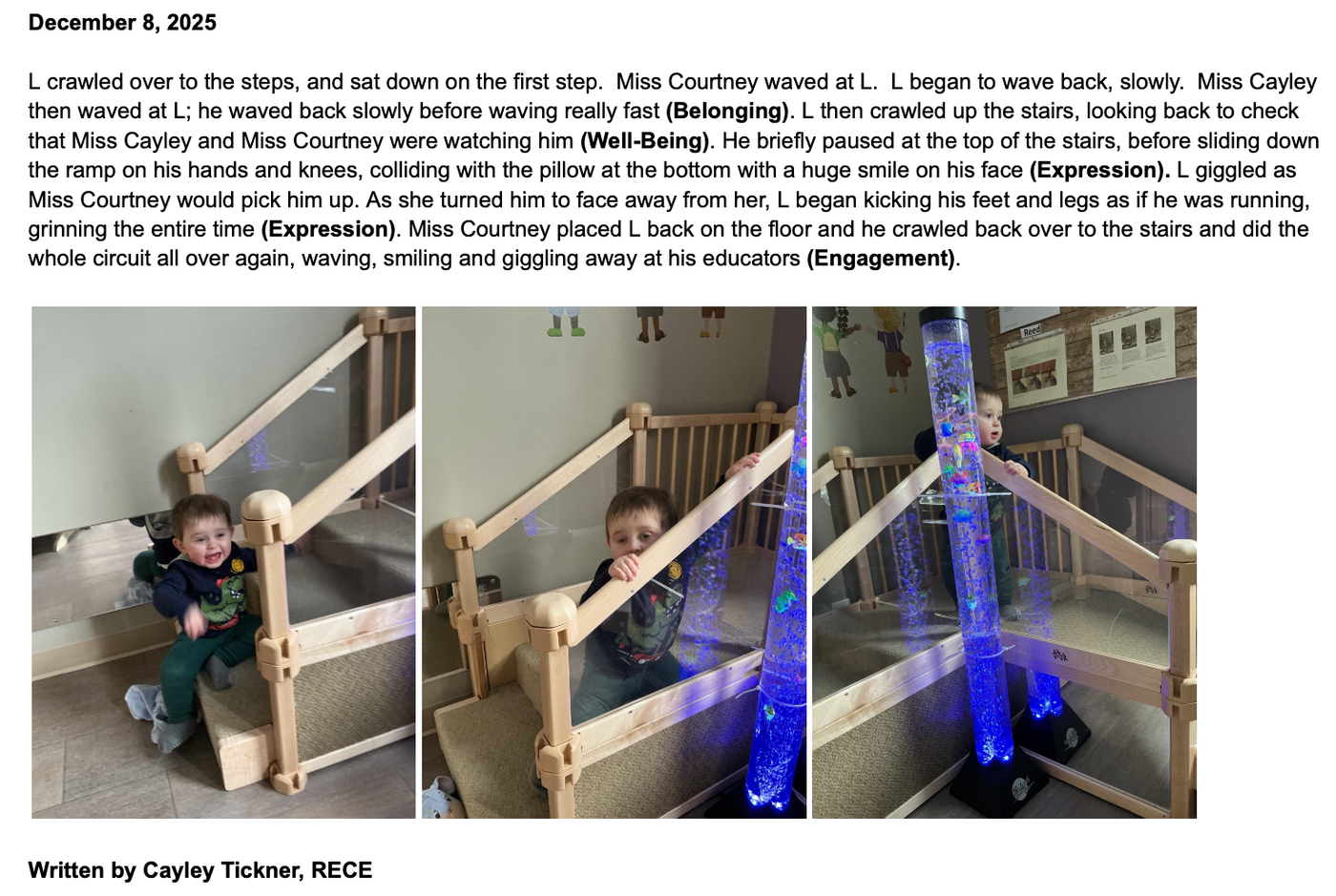
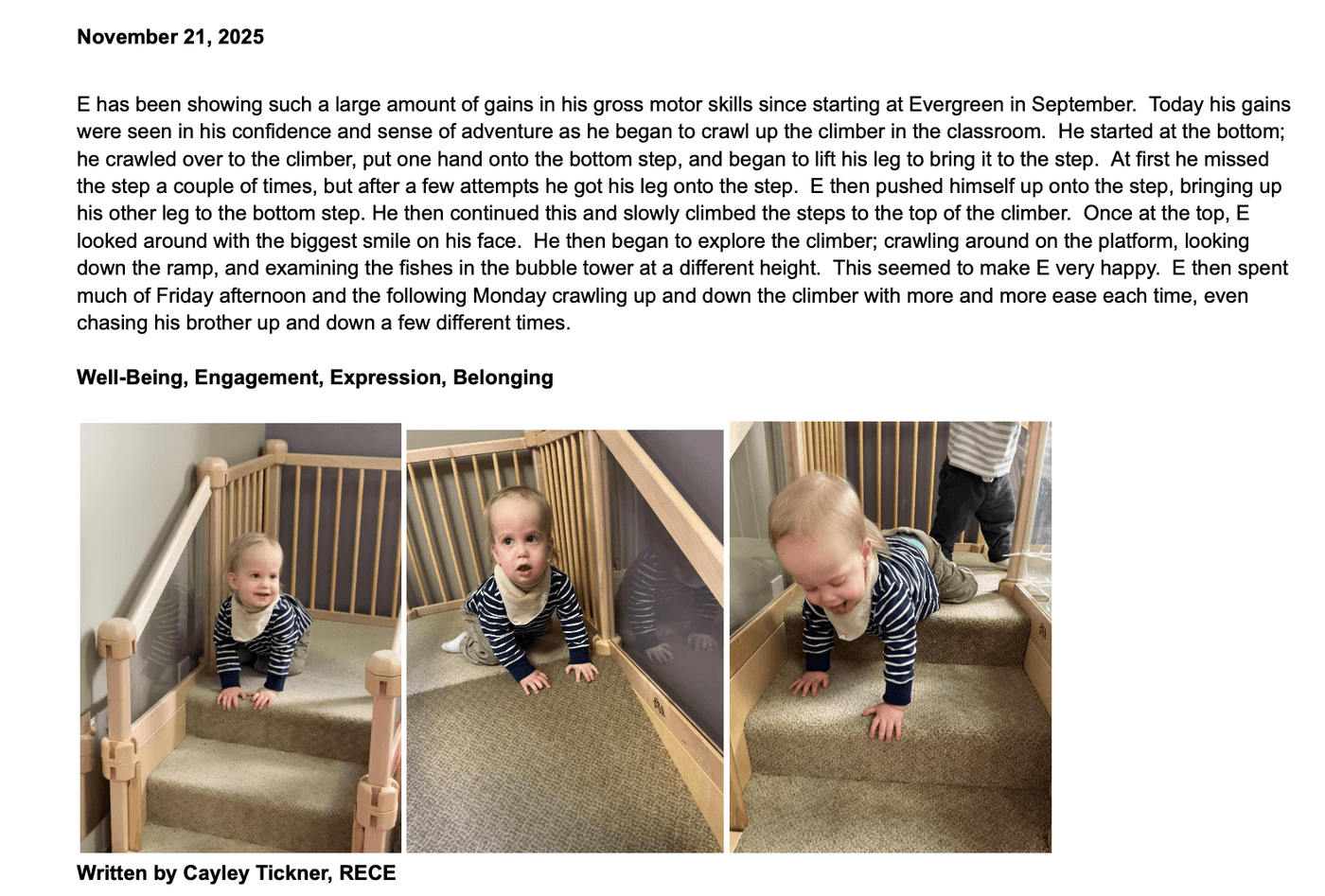

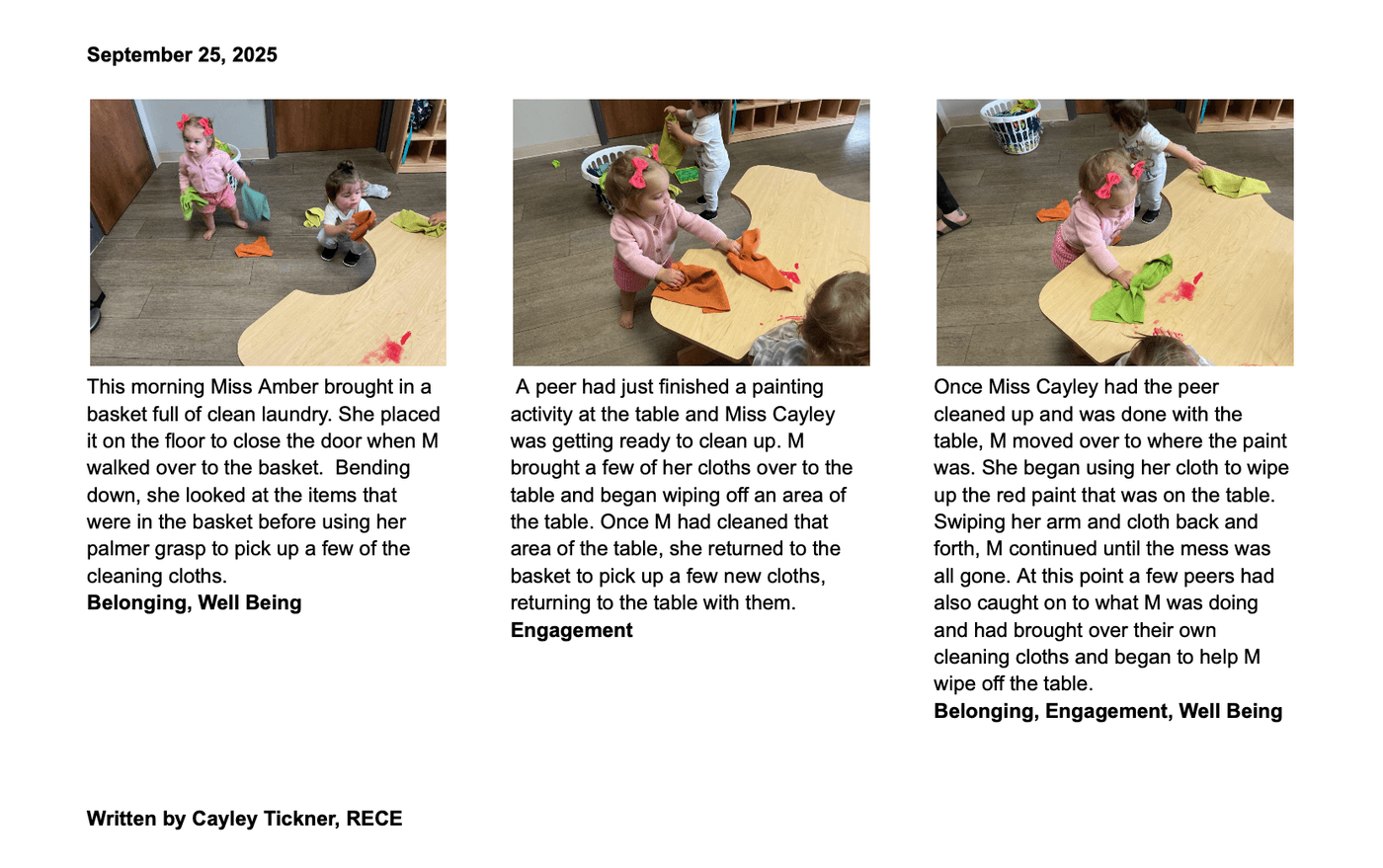
August 20, 2025
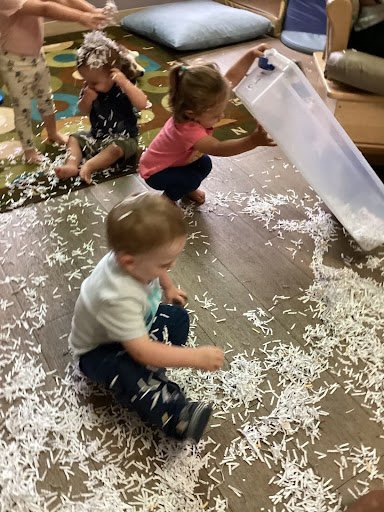
M was ready to investigate the sensory bin before we even added the shredded paper. The educator then dumped shredded paper into the bin. M bent right down, grabbed a handful and brought it right to his mouth. I said, “Oh M, it's not really for eating buddy”. He just stared at me, then tried to get the paper out of his mouth. Then he stood up and started to pull pieces of the paper apart between his fingers.
It did not take long before most of the paper was all over the place. M then sat right down in front of the bin and tried pulling it away. A peer then also pulled on the bin and ended up dumping the rest right out onto the floor. Some of it stayed behind, but most was on the floor. While his peer took care of the rest, M played with the pieces around him. Then he crawled through some of the paper and looked up to see a peer dropping paper onto another peer's head. He walked over to them and stood beside them watching what they were doing. As M moved around the room watching his peers and joining in, he had lots of smiles and made a lot of different vocal sounds. If he was not smiling, he was showing contentment on his face, focusing on what was happening as he manipulated the paper.
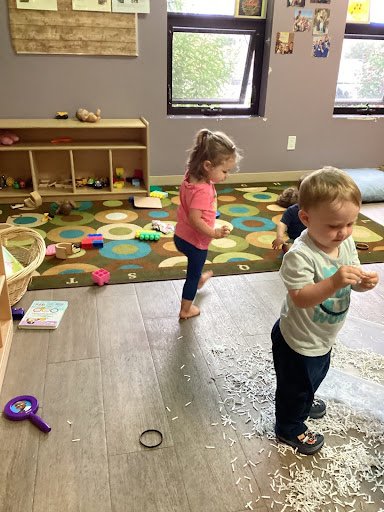
Belonging: M has shown a sense of belonging as he joins in his play along with his peers. He has shown more comfort and is easing better into transitions.
Engagement: M was able to observe his peers and show he is increasing focus. M is learning about cause and effect as he manipulates the paper, doing different things to the paper and watching what happens next.
Well-Being: We see M working on his fine and gross motor skills as he manipulates and tears the paper or when he moves around the room and bends down to pick up the pieces.
Expression: M shows expression as he smiles and makes different sounds as he plays with the paper pieces.
By Mandy Bertling Beres, RECE
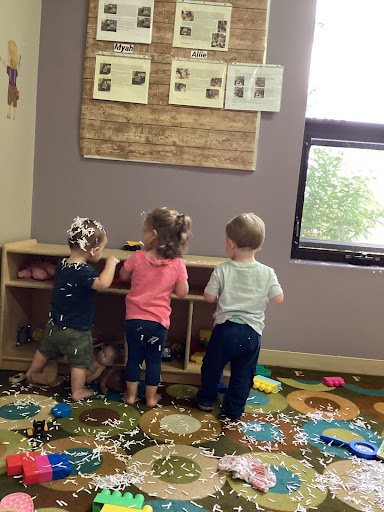
July, 2025
This month we welcomed R along with two more infants to our classroom. Although R had a few tears at drop off, he seemed happy. He was calm most of the day, but would get upset when he heard one of the other new babies cry. He would still smile through his tears, as if to say he was trying to be happy, but the sound of the other crying made him sad.
R was able to explore the room on his own, getting right into play mode and exploring toys. He showed excitement when different activities were set up. He crawled his little body over to the table quite fast, pulling himself up to join in. He smiled and squealed and made all kinds of sounds when trying to help rescue the bugs that were taped to the table.
So far when we are outside he likes to spend most of his time in the sandbox exploring different materials. He uses his hands to scoop and pour sand, watching closely what happens when he tries different objects. The infants have shown us they are happy to have new friends join in by gathering around when someone new comes into the room. They are very inviting and show excitement, and even try to share toys by passing them to our new infants. One of the infants can even point to R's picture and say his name. We are excited to have R in our room and we look forward to watching him learn and grow and build relationships.
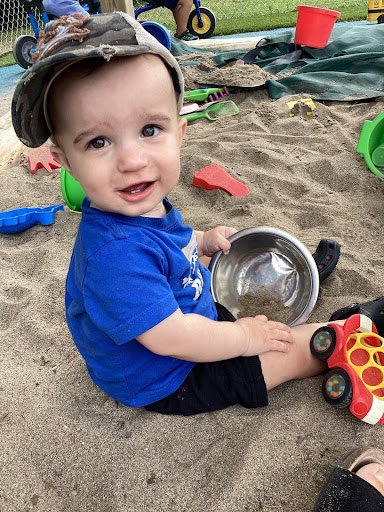
Belonging: R shows he is comfortable and able to explore and transition without any hesitation. He smiles at his teachers and peers, and moves around the room initiating his own play.
Engagement: R is able to join in play and activities on his own. He will keep focus and show determination when rescuing the bugs from tape. He stays engaged in his play when outside in the sandbox and is able to interact with and play beside his peers.
Well-Being: We see R working on many skills as he crawls to the table and pulls himself up to join the activities. He is working on his gross motor skills to get to the table. We see him grasp the whole insect with his hand and try to free it, then he switches to fine motor movements to free it even more.
Expression: Smiles, squeals and different sounds show us R is able to express how he is feeling. He shows sympathy and the beginnings of empathy when he cries hearing another infant crying. Smiling at his educators even though he is crying from the sound of a peer’s cries show us that R is learning about his own emotions.
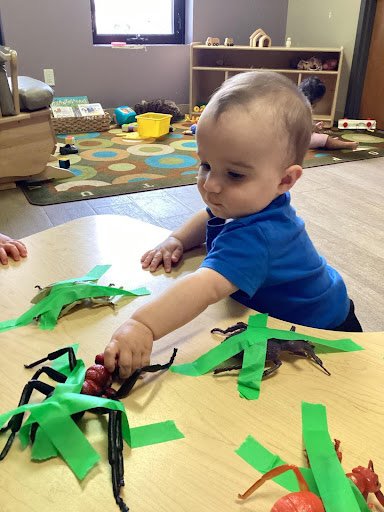
By Mandy Bertling Beres, RECE
June 2025
This month we have enjoyed watching M play and learn. She has shown engagement with both her educators and peers. She showed us her most proud moment when she took her first steps at the centre. We cheered her on and clapped and she smiled with us and clapped her hands as well. We gave her lots of encouragement, and brought in the walker for her to walk with her peers down the hall and out to the playground. Mom and dad were both telling us for a couple of weeks that she had done some steps at home, but we had yet to see her take them here. We kept encouraging her every chance we got, then one day out of nowhere she stood up in our classroom and took a few steps. By the end of the week she was taking more and more. Then the last week of June she was walking everywhere more than she was crawling.
In M's first couple of weeks here she would mostly observe the children participating in activities or go and do her own thing with other toys in the room. Now M shows that she knows she is part of this classroom and feels a sense of belonging. She is eager to participate in activities we set up to do. She loves to be in the sandbox and to engage with her peers both on the playground and in the sanctuary to dance.
Belonging: M shows a sense of belonging, as she participates and engages with her peers and her educators. She shows she is comfortable and feels safe as she participates in ways that are comfortable for her. Offering M a walker allowed her to keep up with her peers as they walked from one area to another to play
Engagement: We see M participating and engaging with peers not only in her classroom, but in other areas of the daycare. She stays focused and is able to observe peers.
Well-Being: M shows she is physically active as she goes from crawling and cruising, to climbing, standing and now walking. She shows a sense of pride by clapping and smiling when she accomplishes the task of taking steps.
Expression: M is able to tell us how she feels. She lets us know she is proud when she smiles and claps after learning to take steps. She is able to let us know when she is tired, hungry or thirsty by her actions and the sounds of her cry. We also know when she is tired when she will rub at her ear and her eye.
.
Written by Mandy Bertling Beres, RECE
May 7, 2025
This week we got to learn about what it is like to go to a Forest School. We spent some time in a small forest on Monday. Then today we got to spend time in a beautiful grassy area. There were lots of bugs, animals, birds, trees and different kinds of plants in this nice big area, allowing us to do a lot of exploring.
When we arrived, we all sat down on a tarp to sing a song with the forest school educator. She also added some really nice pinecones to the area. C checked out the pine cones and even found some dry grass and dandelions to investigate. She slid her fingers up and down the long blade of dry grass and even swiped it along her lips. Next, she picked up a pinecone and a dandelion and smushed the dandelion into the pinecone. After a few minutes, the infants started walking off the tarp and exploring their surroundings.
When C came off the tarp, she walked over to a really pretty flowered tree. She stood there looking at it, then a couple minutes later some peers and the forest school educator came over to see what C was looking at. I could see and hear a lot of bees buzzing around and landing on the flowers. I noticed some of them had a lot of pollen on their back legs. I asked C, “what do you see?” She pointed towards a branch where there was a bee that had landed and made a sound as she pointed. I said, “Oh I see that bee, too. Can you hear anything?” She said, “hmm.” Then I asked as I pointed to my ears, “I can hear a buzzing sound. Do you know who is making that sound?” She looked around the tree and pointed to a bee as it flew from one place to another.
Later, we walked through a path that took us to a grassy area with water on each side. C was a little hesitant when walking through the path as there were many different plants and grasses growing on each side. With some guidance and reassurance, she made it through. Walking to the middle of the grassy area, she sat, taking everything in. There were so many sounds of birds, frogs and things I could not identify. Lastly we picked some cat tails that the infants tore apart and watched float and fly all around.
Belonging: C is able to comfortably examine and explore objects with her peers and share experiences together. She reaches out to the educators when she is unsure and needs help or guidance. She is able to have social interactions with both her peers and educators.
Engagement: C stays focused as she explores different materials in nature, as well as what she sees and hears around her. She was able to focus and move through the crowded path with help from her educator, making it through to the other side.
Well-Being: C uses her fine motor skills as she explores throughout nature. She picks dandelions, grass and pulls apart the cat tails. She builds on her gross motor skills as she climbs through the brush on the path heading to the grassy area between the water.
Expression: C is able to use her words, sounds and actions to express how she feels and also to ask for what she needs help with. She also is able to use them to show what she sees, and as a way to answer questions.
Written By Mandy Bertling Beres, RECE
April 15, 2025
As we welcome K into our classroom, the infants show excitement and interest watching someone new. As Mom and the educators have a chat, the infants watch as Mom takes off his outdoor clothing. K watches his peers with a big smile and lots of waving. K’s sister plays in our room while this is all happening. When K is ready, he is all smiles and waves as his Mom starts to leave the room. His big sister had a hard time saying bye and had some tears. K took to our room and his peers like a pro. He went right into play mode, exploring the room and all of the things to do.
We have explored many different cause and effect provocations and activities during K’s first week with us. We have spent lots of time outside playing and going for walks. K showed the most interest in the plastic bag we taped to the floor full of paint. We used two different colours that reveal a new colour once mixed together. K used his fingers to push the paint around, crushing and mixing it together. He had a look of awe on his face as he moved the paint around, causing it to change colour. Later, he would slap the bag with both of his hands, making a loud splat sound. He had big smiles on his face when slapping at the bag, making tiny giggle noises. When we first placed the bags on the floor with tape, K did not notice as he was engaged in playing on the climber in the corner of the classroom. The other infants noticed right away. They know our routine and do not miss much. They see us talking and putting things together and know right away something fun and new is going to happen. After a few minutes, K looked around. He looks at his peers and knows something is different. That is when he crawls off the play mats, pulls himself up and walks over with a little bit of a wobble right to one of the paint bags. He watches his peers for a minute or two before trying it out for himself.
Belonging: K has been able to make smooth transitions from home to daycare. We have not seen many tears or times of upset. He is always full of smiles and eager to play. His peers have been very welcoming and show they are happy to see him. K shows us he is comfortable in our classroom and easily joins play.
Engagement: K is able to stand back and observe his peers before joining in their play. He is able to stay focused in his play and work alongside his peers once he does join in, showing us that he is able to stay focused when fully engaged in his play.
Well-Being: K shows he is physically active as he climbs around on the climbing mats in our room. He shows confidence in his growing gross motor skills as he makes his way over to the paint bags that are taped to the floor and use his own unique movements (slapping, crushing) to manipulate the bag. He shows he can cope with changes and transitions as he is welcomed into our classroom.
Expression: K is able to express himself with his facial expressions and giggles as he plays alongside his peers. He is able to let us know when he is upset or needs something by using actions, sounds or cries.
By Mandy Bertling Beres, RECE
March 11, 2025
I started to blow bubbles using the bubble wand. F sat on the floor by the kitchen and watched me for a few minutes, following the bubbles around with her eyes. She then decided to stand up and watch some more as the bubbles floated around. F looked at the bubbles as they were coming down and said the word, “Bubble.” F had a huge smile on her face. She then walked into the bubbles floating in the air and started popping them. To pop the bubbles, F used her hands, sometimes making a clapping motion. She would also use her index finger to poke the bubbles and her feet to stomp on the bubbles. When F popped the bubbles she always had a big smile on her face and sometimes she giggled and laughed out loud with her friends. Her friends joined in all the fun alongside her with popping the bubbles as well.
Belonging: F examined and popped the bubbles with her friends. They all had lots of laughs and smiles while playing with the bubbles.
Engagement: F had increased focus while watching the bubbles and popping them. She used a variety of different ways to pop the bubbles.
Well-Being: F coordinated her body movements using her fine and gross motor skills. She also showed a sense of pride and accomplishment when she popped the bubbles by laughing and giggling. When F used her eyes to follow the bubbles she was showing visual tracking skills.
Expression: F laughed and giggled with her friends while popping the bubbles. She also said the word “Bubble” out loud, increasing her vocabulary.
Written by Amber Sinnesael, RECE
February 12, 2025
We have been focused on everything senses in our classroom. We have been talking about our different body parts and what they can do. I grabbed a couple of the paint shirts from the cupboard. A was watching me and scooted right over to me, putting her hands up, showing she was ready to put her paint shirt on. I had been mixing up some vanilla and chocolate pudding in containers with a paintbrush and water. I put her in a highchair once she was ready, buckled her in and placed the tray on. Then I placed a piece of coloured paper on her tray with a dish of chocolate pudding with a paintbrush, and a dish of vanilla with a paint sponge. A just looked at me and looked at what was in front of her. She turned and looked at a peer, who was doing the same, neither one of them picking up the materials. I then picked up the paintbrush with chocolate pudding and made a mark on the paper. Next I handed the paintbrush to A and said, “Do you want to try it?”
She picked up the brush and started to make chocolate marks on the page. I then showed her that she could do the same with the vanilla pudding. She picked up the vanilla sponge brush. I thought she was going to paint with it, but it went straight to her mouth. She made sounds of “yum” while she ate it. She would dip it back in the vanilla and eat more. A did not paint at all with the vanilla pudding. She kept eating the vanilla and painting with the chocolate, smiling and making noises as she went.
Belonging: A observes her peers while playing parallel to them. She imitates the educator when shown an example of what she can do with the pudding paints. She is able to keep eye contact with the educator when she is being spoken to, and watches her movements as she is shown ways to use materials in front of her.
Engagement: After I showed A how to use the material, she stayed focused on what was in front of her; painting, eating, smiling, making sounds and showing she was right into the activity. She kept her focus on the activity and watching what happens as she places the brush on to the paper.
Well-Being: A shows she can use her palmar grasp and eye-hand coordination to make marks on the paper. A shows she is exploring with her sense of taste. I wonder if she could smell the pudding before she decided to taste it. Maybe she did not like the look of the chocolate, as she did not taste it.
Expression: A is able to understand the educator as she follows through with using the paintbrush on her own. She is able to communicate that she likes the taste of the pudding when she makes sounds that sound like she is enjoying it.
Written By Mandy Bertling Beres, RECE
January 6, 2025
After being dropped off, M needed a couple minutes to calm down. Once she was calm, I set her down on the carpet and she sat and watched the other infants for a few minutes. Then she started picking up toys that were close to her. After a while longer, she started walking around the room, playing with other toys. One of the infants was playing with a pvc pipe and was dropping it on the hard floor. It would make a loud sound as it was dropped. M made her way over to her peer and picked up one of the pipes that was on the floor beside him. She then dropped the pipe on the ground, watching as it fell and squinting her eyes as it made a loud sound. After she dropped it, her peer would pick it up and hand it back to her. They went back and forth, dropping and picking up the pipes, for quite some time. Then I showed M that she could put a ball down the tube. She tried herself a couple of times but then continued to drop the pipe again and again.
Later in the day, we tried different types of balls in the pipes and put our ears up to it to see what sounds they would make. I watched M’s face as I did this and you could see her eyes move and her head tilt as she heard the sounds being made.
Belonging: M shows us she is able to interact with peers and teachers. She shows that she can participate in ways that she feels comfortable. She takes her time when coming into the classroom as she transitions from home to daycare, and is comforted by her educators.
Well-Being: As M takes her time transitioning from home and moves around the room before joining play with a peer, she shows us that she knows she has control over herself and her decision making. She also shows that she is capable of initiating their own learning.
Engagement: As M plays with the pipes, she is interacting with a peer and is increasing her observation skills as she watches her peer. As she watches and listens to the pipe as it falls and hits the ground, she is learning how to investigate, testing theories and her problem solving abilities.
Expression: M is able to communicate with her peers as they use non verbal communication by handing the pipes back and forth to each other. Her expressions show us how she is responding to the sounds and the movement of the pipes
By Mandy Bertling-Beres, RECE
